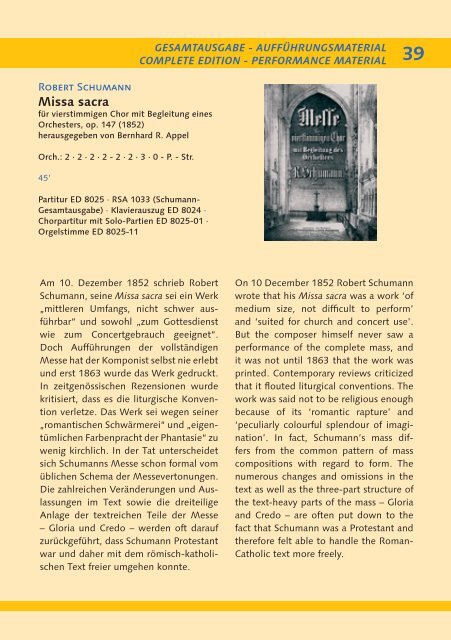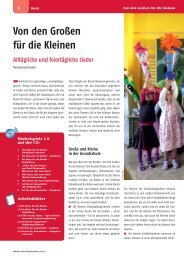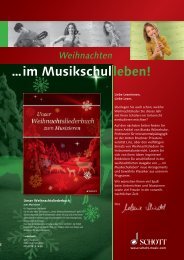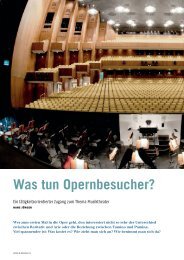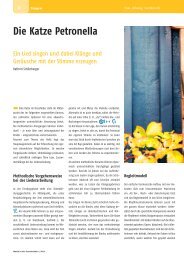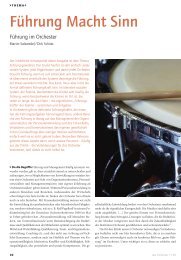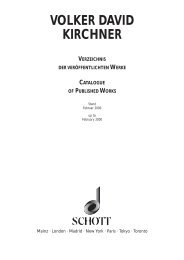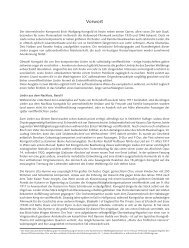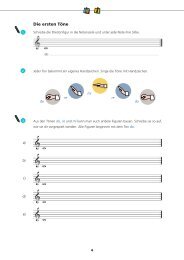Remember Schumann … - Schott Music
Remember Schumann … - Schott Music
Remember Schumann … - Schott Music
Erfolgreiche ePaper selbst erstellen
Machen Sie aus Ihren PDF Publikationen ein blätterbares Flipbook mit unserer einzigartigen Google optimierten e-Paper Software.
Robert <strong>Schumann</strong><br />
Missa sacra<br />
für vierstimmigen Chor mit Begleitung eines<br />
Orchesters, op. 147 (1852)<br />
herausgegeben von Bernhard R. Appel<br />
Orch.: 2 · 2 · 2 · 2 - 2 · 2 · 3 · 0 - P. - Str.<br />
45’<br />
Partitur ED 8025 · RSA 1033 (<strong>Schumann</strong>-<br />
Gesamtausgabe) · Klavierauszug ED 8024 ·<br />
Chorpartitur mit Solo-Partien ED 8025-01 ·<br />
Orgelstimme ED 8025-11<br />
GESAMTAUSGABE - AUFFÜHRUNGSMATERIAL<br />
COMPLETE EDITION - PERFORMANCE MATERIAL 39<br />
Am 10. Dezember 1852 schrieb Robert<br />
<strong>Schumann</strong>, seine Missa sacra sei ein Werk<br />
„mittleren Umfangs, nicht schwer ausführbar“<br />
und sowohl „zum Gottesdienst<br />
wie zum Concertgebrauch geeignet“.<br />
Doch Aufführungen der vollständigen<br />
Messe hat der Komponist selbst nie erlebt<br />
und erst 1863 wurde das Werk gedruckt.<br />
In zeitgenössischen Rezensionen wurde<br />
kritisiert, dass es die liturgische Konvention<br />
verletze. Das Werk sei wegen seiner<br />
„romantischen Schwärmerei“ und „eigentümlichen<br />
Farbenpracht der Phantasie“ zu<br />
wenig kirchlich. In der Tat unterscheidet<br />
sich <strong>Schumann</strong>s Messe schon formal vom<br />
üblichen Schema der Messevertonungen.<br />
Die zahlreichen Veränderungen und Auslassungen<br />
im Text sowie die dreiteilige<br />
Anlage der textreichen Teile der Messe<br />
– Gloria und Credo – werden oft darauf<br />
zurückgeführt, dass <strong>Schumann</strong> Protestant<br />
war und daher mit dem römisch-katholischen<br />
Text freier umgehen konnte.<br />
On 10 December 1852 Robert <strong>Schumann</strong><br />
wrote that his Missa sacra was a work ‘of<br />
medium size, not difficult to perform’<br />
and ‘suited for church and concert use’.<br />
But the composer himself never saw a<br />
performance of the complete mass, and<br />
it was not until 1863 that the work was<br />
printed. Contemporary reviews criticized<br />
that it flouted liturgical conventions. The<br />
work was said not to be religious enough<br />
because of its ‘romantic rapture’ and<br />
‘peculiarly colourful splendour of imagination’.<br />
In fact, <strong>Schumann</strong>’s mass differs<br />
from the common pattern of mass<br />
compositions with regard to form. The<br />
numerous changes and omissions in the<br />
text as well as the three-part structure of<br />
the text-heavy parts of the mass – Gloria<br />
and Credo – are often put down to the<br />
fact that <strong>Schumann</strong> was a Protestant and<br />
therefore felt able to handle the Roman-<br />
Catholic text more freely.


